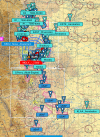Ed Haywood
En-Route
Anyone do this? I never have, but I might start.
My practice area is southeast of Tampa, under the outer ring of class B. It meets requirements for distance from airways, but there is a lot of random GA traffic in the area transiting to Lakeland, Sarasota, etc. It is within the mode C veil so everyone should be broadcasting ADS-B out.
Aerobatic maneuvering will outpace ADS-B refresh and result in collision warnings to yourself. But a quick scan of the fish finder before starting a sequence is a good way to verify any aircraft on a path to enter the practice area in the next 2-3 minutes, a typical sequence length. Visual clearing turns give you 1 minute as best.
Edit: a lot of readers are interpreting this as "instead of visual clearing". Not the case; ADS-B would be in addition to clearing turns. However, clearing turns are limited by visual range. I have never been able to spot a small GA aircraft beyond 3 miles, which is 60-90 seconds of cruise flight time. An aerobatic sequence lasts 3 to 4 minutes, during which continued visual clearance is impossible. Therefore, I need a means to detect aircraft on a path towards me with a range from 3 to 12 miles.
Edit 2: yes I know, not all aircraft have ADS-B. But I'm not worried about Cubs and Champs blasting into my practice area. They are slow.
My practice area is southeast of Tampa, under the outer ring of class B. It meets requirements for distance from airways, but there is a lot of random GA traffic in the area transiting to Lakeland, Sarasota, etc. It is within the mode C veil so everyone should be broadcasting ADS-B out.
Aerobatic maneuvering will outpace ADS-B refresh and result in collision warnings to yourself. But a quick scan of the fish finder before starting a sequence is a good way to verify any aircraft on a path to enter the practice area in the next 2-3 minutes, a typical sequence length. Visual clearing turns give you 1 minute as best.
Edit: a lot of readers are interpreting this as "instead of visual clearing". Not the case; ADS-B would be in addition to clearing turns. However, clearing turns are limited by visual range. I have never been able to spot a small GA aircraft beyond 3 miles, which is 60-90 seconds of cruise flight time. An aerobatic sequence lasts 3 to 4 minutes, during which continued visual clearance is impossible. Therefore, I need a means to detect aircraft on a path towards me with a range from 3 to 12 miles.
Edit 2: yes I know, not all aircraft have ADS-B. But I'm not worried about Cubs and Champs blasting into my practice area. They are slow.
Last edited:

 as I am often they guy in the J-3, Taylorcraft, Champ, or Glider.
as I am often they guy in the J-3, Taylorcraft, Champ, or Glider.
